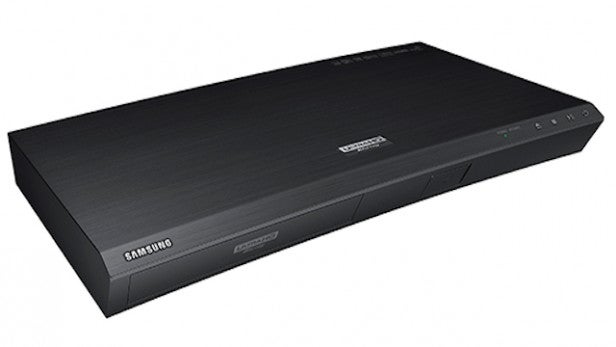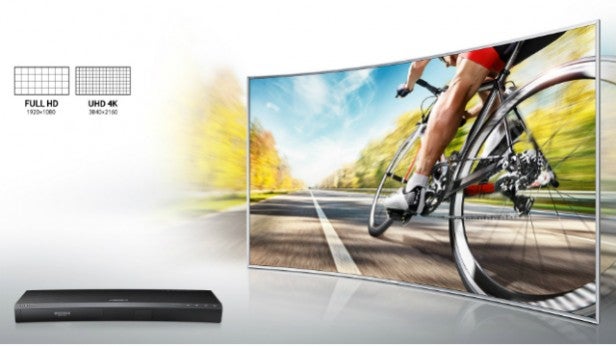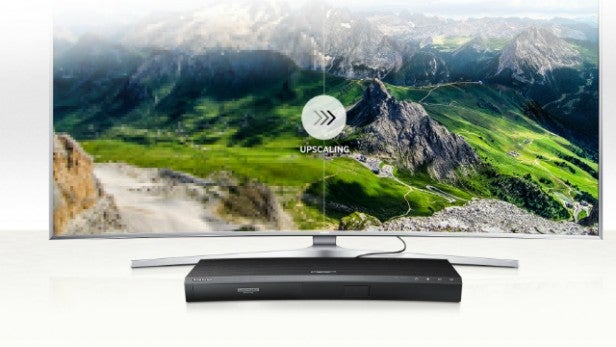Samsung UBD-K8500 Ultra HD Blu-ray Player Review
Samsung UBD-K8500 Ultra HD Blu-ray Player
How good is the cheaper of the two UHD players?
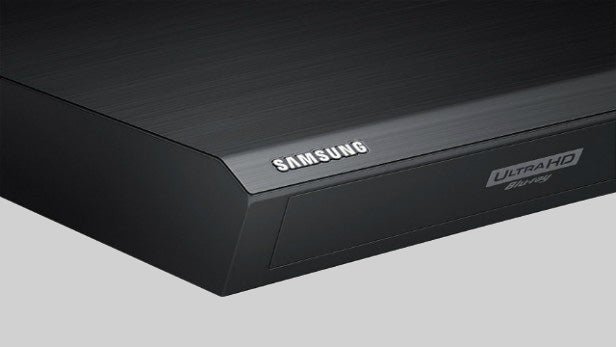
Verdict
Pros
- Stunning 4K HDR pictures
- Generous features
- Quick disc loading and slick menu system
- Lower price than expected
Cons
- Panasonic rival offers superior pictures
- Limited disc releases
Key Specifications
- Review Price: £429.00
- Ultra HD Blu-ray disc support
- High Dynamic Range and wide colour gamut
- Plays 3D Blu-rays
- 4K upscaling
What is the Samsung UBD-K8500?
It’s been a long time coming but Ultra HD Blu-ray is finally here, and as ever Samsung is leading the charge. The UBD-K8500 is the Korean company’s first 4K player and finds itself in a two-way tussle with the Panasonic DMP-UB900 – a throwback to 2006 when Samsung’s BD-P1000 battled it out with the Panasonic DMP-BD10 at the birth of Blu-ray.
Ultra HD Blu-ray offers a resolution of 3,840 x 2,160 pixels – four times that of Blu-ray’s 1,920 x 1,080 – which potentially delivers clearer, sharper pictures. But increased resolution is not the format’s only selling point. High Dynamic Range (HDR) potentially has a bigger impact on picture quality, offering brighter whites and deeper blacks, while the format’s wider colour gamut delivers more accurate colours.
The first batch of Ultra HD Blu-ray discs has already hit UK shelves, including titles like Kingsman: The Secret Service, Life of Pi and X-Men: Days of Future Past – all of which offer HDR and sell for £19.99 each.
Video: Trusted Explains – All you need to know about 4K and HDR
Samsung UBD-K8500 – Design and Connections
On close inspection, the UBD-K8500 isn’t quite the premium proposition I expected for the money, but it’s a stylish and well-made machine. Samsung sticks with the curved design of its recent Blu-ray decks to match its curved TVs, but the jutting angles and classy brushed black finish take the deck in an even sleeker direction.
A row of four touch-sensitive controls runs along the front edge but there’s no display panel, just a small power LED that glows red or green. Lower down the front panel is a USB port covered by a clunky plastic flap, alongside the disc tray.
The rear panel is sparse but that’s hardly surprisingly when HDMI does most of the donkey work. However, the inclusion of two HDMI outputs is very welcome. It means that you can feed 4K pictures to your TV from the main output while piping audio to your AV receiver separately – essential if your receiver doesn’t support 4K signals.
The main HDMI 2.0a output supports HDR and uses HDCP 2.2 copy protection. Joining the HDMIs are optical digital output and an Ethernet port, which you can use instead of the built-in Wi-Fi to access the deck’s online goodies (more on that later). And Samsung has a message for those expecting analogue audio connections: get with the times, granddad.
Related: Ultra HD Blu-ray: Everything you need to know
Samsung UBD-K8500 – Features
Ultra HD Blu-ray playback is the star attraction, but the UBD-K8500 is crammed full of other features. For starters you can play all of your existing Blu-ray discs and DVDs (with 4K upscaling) and although 3D isn’t part of the UHD Blu-ray spec you can play 3D Blu-rays too. It spins CDs, but not SACD or DVD-Audio.
The deck also plays content from USB drives connected to the front port, including any 4K video files you have in your collection. MKV, DivX, AVCHD, WMV and JPEG are all supported.
The deck offers a wide range of online apps including Netflix and Amazon Instant Video, both of which offer 4K streaming (but not HDR support). Their inclusion is welcome, but they might end up being redundant if they’re built into your 4K TV already.
Also on board are Spotify, Deezer, All4 and loads more in the Samsung Apps section, but oddly there’s no BBC iPlayer or ITV Hub – these will be added with a software update.
You can stream music, video and photo files from PCs and NAS drives on your home network and use screen mirroring to view a smartphone on your TV. The deck also offers 7.1-channel Dolby True HD and DTS HD Master Audio decoding and bitstream output via HDMI.
Related: What is 4K TV and Ultra HD?
Samsung UBD-K8500 – Setup & Operation
The UBD-K8500 sticks with the same bright and breezy menu system as its regular Blu-ray players, which is a good thing. The Home screen uses three large panels – Play Disc, Multimedia and Samsung Apps – with selected apps and other options running along the bottom.
It’s all very colourful and welcoming, ideal for AV virgins and veterans alike. The deck delves into NAS drives with no messing about and navigates through labyrinthine folder structures quickly and smoothly. Videos and songs load instantly, while the use of cover art and bright graphics make it a gratifying process.
The setup menu features a thorough range of settings – including an HDMI Colour Format option – while the grid-style Samsung Apps screen makes it easy to find and install the software you want.
I whipped out the stopwatch and timed how long the deck took to load UHD Blu-ray platters – nineteen seconds on average. Not the week-long wait of the first Blu-ray decks, then. As for Blu-ray, it started playing the stubborn Terminator Salvation disc in a mere 20 seconds.
The UBD-K8500’s remote is compact and slender with pared-down buttonry. It looks like the Smart Control remote that comes with Samsung’s latest TVs. The zapper sits nicely in the hand and the layout is generally intuitive, but there’s one big flaw – to scan through a disc you have to hold down the chapter skip keys. The longer you hold it, the faster it goes.
Samsung UBD-K8500 – Performance
With the UBD-K8500 connected to Samsung’s HDR-capable UE55KS9000T TV, I ripped the cellophane from Life of Pi and The Martian and settled in for some 4K action.
And sure enough, the UBD-K8500 delivers eye-popping images, with intense detail and an overall sense of three-dimensionality that common-or-garden Blu-ray simply can’t deliver – provided your TV’s good enough to make the most of it, that is.
Take a look at the sea of meerkats that Pi discovers on the carnivorous island – the clarity and punch of the scene is stunning. Every meerkat in the shot is clearly defined, right down to their little black eyes and tufts of hair. As the swarms ripple and stand to attention, the deck resolves the patterned movement with a steady, focused hand.
Related: What is HDR and should you care?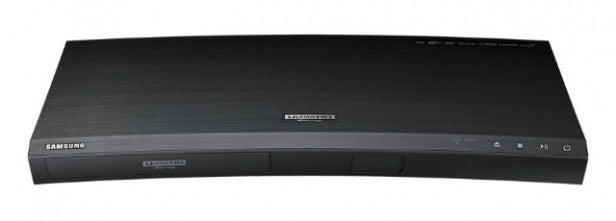
Elsewhere the disc is packed with luxurious images that showcase the benefits of UHD Blu-ray. Shots of the island reveal individual leaves on trees, crisp ripples in the water and the grainy texture of moss covering the floor. Richard Parker’s CG fur and the scuffed wooden interior of the boat are with pin-sharp clarity.
But before I get too carried away, Ultra HD Blu-ray’s picture quality isn’t quite the revelatory experience you might expect in terms of resolution. Sure, pictures look cleaner and sharper than Blu-ray, but it’s not the epiphany I felt when moving from DVD to Blu-ray.
Part of the problem is that most of the first Ultra HD Blu-ray discs have been upscaled to 4K from 2K masters – as is the case with the discs I’m using here. Most of Sony’s first discs, including Chappie and The Amazing Spider-Man 2, have been created from a 4K digital intermediate and are more likely to show off the format to its full potential. But the bottom line is that picture quality varies from disc-to-disc.
But resolution isn’t the story here anyway. The real advantages of Ultra HD Blu-ray are High Dynamic Range and the extended colour gamut. On a good quality HDR TV, the Samsung delivers a punchy, expansive image that really pops from the screen. Blacks are profoundly deep and inky while small dots of light are bright and piercing.
For example, as Pi gazes up at the night sky from the boat, the brighter stars are strong, concentrated dots of light shooting through the dense black sky with no bleed to sully their clarity. It conveys the differing levels of brightness among the other stars too. Look down at the sea and the crisp, candescent glow of the jellyfish surrounding the boat is utterly hypnotic.
Similar highlights can be seen in The Martian, such as the spinning light beacon at the start of chapter four, which punches through the Martian darkness. But it’s not only dark scenes that benefit – brightly lit shots of Matt Damon moving equipment around look dense and textured. 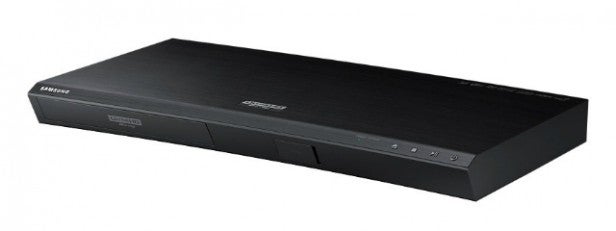
HDR is a revelation, but for me 4K Blu-ray’s wide colour gamut is the feature that really takes the format to the next level. Not only do the UBD-K8500’s colours look deeper and more realistic, but they also boast smoother gradation and greater subtlety than regular Blu-ray.
To benefit from this outstanding colour reproduction, you need to enable the TV’s HDMI UHD Color setting on the HDMI input you’re using. This isn’t activated automatically.
To assess how Ultra HD Blu-ray’s colours compare with regular Blu-ray, I connected an OPPO BDP-105D Blu-ray deck to a different HDMI input on the TV and loaded the Life of Pi Blu-ray that comes with the UHD version. After synchronising both players and selecting the TV’s ‘Movie’ preset on both inputs, I switched between them and compared picture quality.
At the start of chapter four the camera tilts down and settles on an Indian tea field. What jumps out is the Samsung’s superior reproduction of the tea plants. The shades of green look richer, more natural and, well, greener.
On the Blu-ray version, the colours look more garish and have a yellow tint. The Samsung also offers a more accurate reproduction of the blue sky above, bringing it closer to what you’d expect to see in real life. 
This combination of HDR and a wider colour gamut results in a wonderfully natural, cinematic viewing experience. But what you shouldn’t expect from HDR is a super-bright, eye-frazzling image. That’s not the point. HDR allows the extremities of light in the picture to be expanded, rather than boosting the overall brightness.
As a result, UHD Blu-ray images can seem dimmer than regular Blu-ray, which might take some getting used to. It’s also worth noting that HDR isn’t best suited to rooms with lots of ambient light. During the daytime I occasionally struggled to pick out detail in the HDR image – ideally you need a pitch-black room to make the most of it.
Viewed on a non-HDR 4K TV – in this case the Samsung UE55HU7500T – the UBD-K8500 still does a bang up job. The player’s on-board HDR to SDR conversion keeps distracting artefacts to a minimum, although pictures inevitably lack the punch and lustre of HDR.
With precious few UHD Blu-ray discs available at present, chances are you’re going to want to spin your existing Blu-ray and DVD collection on the UB-K8500. If so, you’re in good hands. Blu-ray discs are competently upscaled to 4K resolution, offering gloriously sharp and solid pictures – the only problem is that once you’ve seen UHD Blu-ray, you won’t want to go back.
Naturally, upscaled DVDs are at the bottom of the picture pecking order with their soft, smeary appearance, but the Samsung’s solid upscaling means the image is far from unwatchable.
Should I buy the Samsung UBD-K8500?
Had Samsung’s UBD-K8500 shared the £1k launch price of its debut Blu-ray deck, right now I’d be advising you to sit tight until prices come down.
But that’s not the case. At £429 Samsung is dangling a rather tasty carrot before your eyes, making 4K Blu-ray more tangible than you might imagine. It’s not an extortionate amount of money by any means, even cheaper than some high-end Blu-ray decks. Crucially, it also costs less than Panasonic’s £600 DMP-UB900.
Make the investment and you won’t regret it. On a good-quality 4K HDR TV you’ll be treated to stunning pictures with outstanding depth, pin-sharp detail and rich, realistic colours. With certain discs you might not notice a huge step-up in resolution from Blu-ray, but thanks to HDR and an expanded colour range you will enjoy some of the punchiest and most realistic pictures ever seen on a home cinema screen.
And like Samsung’s regular Blu-ray decks, the UBD-K8500 is a cinch to use and offers a wealth of features – including 4K streaming from Amazon and Netflix, DLNA and backwards compatibility with all your existing discs.
As with any new format there are a couple of sticking points. Discs are currently thin on the ground, and not all of them take full advantage of the 4K format – but that’s not Samsung’s fault.
The only real downside is that Panasonic’s DMP-UB900 4K player offers a better video performance than the Samsung – as you might expect from a deck costing a good £170 more. But, judged on its own merits, the UBD-K8500 is a terrific player that gets Ultra HD Blu-ray off to a very encouraging start.
Verdict
Samsung’s debut UHD Blu-ray deck is an impressive machine, offering dazzling 4K pictures and loads of features for a lower price than you might expect – although Panasonic’s pricier rival offers a better performance.
Trusted Score
Score in detail
-
Performance 8
-
Design 8
-
Features 9
-
Value 8

